Industrial Ecology Cartoon competition
We are pleased to announce the 1st Industrial Ecology Cartoon competition, launched on Feb 1, 2022.
The 1st ISIE Cartoon competition is now over and we are happy to announce the winners . The idea behind the competition was to foster innovative and creative cartoons that will help to explain to the public some of the important industrial ecology concepts and research.
The competition was open for submissions since February and ended at the end of May. We had total of 7 submissions received and finally after member voting process we are happy to share with you the final results:
1st place winner- Souhil Harchaoui , cartoon title: “Not easy to teach or learn industrial ecology” – 500 EURO cash prize
For the 2nd place, we had two close runners so they will split the prize of 250 EURO. The winners are:
John Mulrow, cartoon title: “also Trees”
Laura Felicio, Quratulain Tariq, Gabriel Carmona and Kai Whiting, cartoon title: “What is energy?”
Congratulations to our winners!
We want to thank the ISIE board for making funds available for this initiative. And we would like to encourage you all to keep sharing visuals to help the community spread the contents and idea in a more welcoming way.
See you all in the next competition!
The competition committee: Ned Gordon, Reid Lifset, Paul Hoekman, and Vered Blass
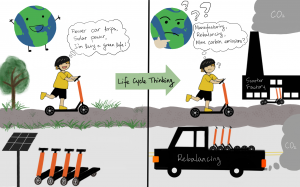
Don't judge a book by its cover
- Submitted by:
- Hao Luo
- Authors:
- Hao Luo
- Description:
- The transportation sector has become one of the largest greenhouse gas sources in the world. Shared micro-mobility, such as bike-sharing, shared e-bikes, and shared e-scooters, gave people the impression that it is a promising solution to reduce greenhouse gas emissions, by replacing car trips and fossil fuel consumption. However, shared micro-mobility cannot guarantee the emission reduction benefit, from a life cycle thinking. First, manufacturing shared infrastructures (e.g., stations, docks, PV panels, batteries, shared vehicles) can generate a large number of carbon emissions. Second, daily operation, especially vehicle rebalancing (moving shared vehicles to under-supplied regions with trucks) and electricity charging (to power e-bikes and e-scooters) may also generate emissions. Considering these embedded emissions, shared micro-mobility itself could be another polluter. Third, the emission reduction benefits depend on whether customers use this service to replace car trips. But very likely, customers may use it to replace walking, which cannot bring any emission reduction benefits. Estimation of its environmental impact requires a life cycle approach to consider both the carbon footprint and handprint at every life cycle stage. Although the life cycle assessment is a commonly used method for environmental impact analysis in the Industrial Ecology community, sometimes it is still not easy for the public or other stakeholders to acknowledge our research work, especially when the result conflicts with their impression. The goal of this cartoon is to provide some insights for our researchers to better deliver the life cycle thinking concept and translate the research results.
- License applied:
- No license (all rights reserved)
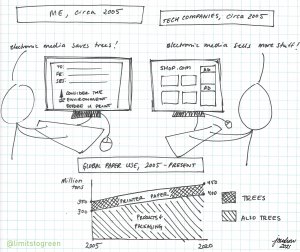
Also Trees
- Submitted by:
- John Mulrow
- Authors:
- John Mulrow
- Description:
- One of my research activities is testing environmental assessment methods at a macroeconomic scale. I ask, how do product-level efficiencies translate to economy-wide impact reductions? If we want to capture the savings from efficiency-gain at that scale, what conditions are required? This is, of course, a question of limits to growth. The cartoon, "Also Trees" is part of a series of industrial ecology-related sketches that I have shared on social media over the past year, exploring the limits to our traditional ideas about sustainability and environmental impact. In this episode, I reflect on my own efforts to promote e-mail as an alternative to paper-mail. I was a huge advocate of this during my undergraduate years at Stanford. Of course, this was in the heart of Silicon Valley in the same years that online retail and advertising were just taking off! We can find plenty of industrial ecology studies from that time touting the efficiencies and potential benefits of moving from paper to electronic media, but very few of them made an effort to think about how the internet would grease the wheels of commerce and consumerism. Here, I show how "electronic media saves trees" turned into even more tree-use; grown, harvested, and sitting on our doorsteps as cardboard boxes full of consumer goods. Macroeconomic adjustment remains a major conceptual and analytical blind-spot among environment assessment scientists, including industrial ecologists, as I have shown here: https://iopscience.iop.org/article/10.1088/1748-9326/ac413b The cartoon's preferred caption is: "In 2005 we were hoping that e-mail and electronic media would reduce paper use. Almost two decades later what we have is more and more of the Earth extracted, processed, packaged in cardboard boxes, and delivered to our doorsteps." Graph of paper industry data based on : McKinsey, 2019. “Pulp, paper, and packaging in the next decade: Transformational Change.” www.mckinsey.com/industries/paper-forest-products-and-packaging/our-insights
- License applied:
- No license (all rights reserved)
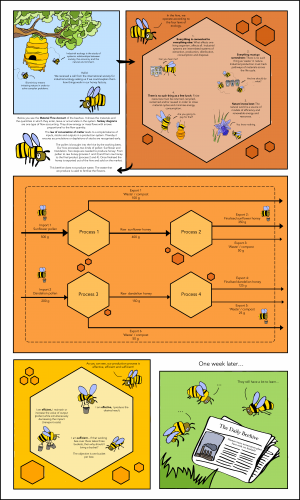
Beehive Biomimicry
- Submitted by:
- Annechien Hoeben
- Authors:
- Annechien Dirkje Hoeben
- Description:
- Human production systems are often considered technologically advanced and innovative. However, all phases of production, from raw material extraction to waste disposal, cause massive environmental problems. As a result, we constantly have to find solutions for problems we create ourselves. But why are we constantly re-inventing the wheel? What if the very best solutions could be found by simply observing nature? After all, nature has perfectly designed, adapted and developed a variety of thriving ecosystems filled with a rich diversity of species. Let’s call it 5 billion years of R&D experience. The concept of biomimicry entails looking at the natural world as a blueprint to solve complex problems, such as environmentally unfriendly production processes. With that in mind, who better to explain industrial ecology than honeybees? These friendly little buzzing creatures have 100 million years of experience in honey production. Plus, they are great cartoon material. This infographic explains various notions within the industrial ecology using the example of a beehive. Let’s get “buzz-y” studying it! Ps. A few fun examples of brilliant honeybee design: • A bee has to eat four kilos of honey to make half a kilo of wax to safely store honey and larvae in. This has to be done efficiently! The modular hexagonal honeycomb makes the most storage possible with the least amount of material. Architects have observed this design and applied it to the Sinosteel skyscraper in Tianjin (China). • A bee has 300-degree field of vision and thereby literally eyes in the back of their head. Nissan Motors is working on a laser range finder that will detect and avert potential collisions, inspired by such curved and compound eyes. • Bumblebees are fluffy and heavy, yet they can fly with incredible efficiency and manoeuvrability. This is thanks to their two-parts wings for flight and landing. What if airplanes could do that? Pps. These wonderful creatures are worth protecting! A few ways to do so: • Turn your outside lights of at night • Place a bee hotel in your garden or on your balcony • Plant some bee-friendly flowers • Try to eat pesticide-free vegetables and fruits
- License applied:
- No license (all rights reserved)
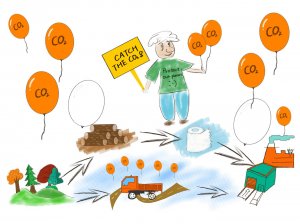
CONTROL THE REAL CARBON NEEDS LIFE CYCLE THINKING
- Submitted by:
- Dingfan Zhang
- Authors:
- Ju Wang, Wei Xie, Min Dai, Dingfan Zhang
- Description:
- Achieving carbon neutrality requires people to manage the carbon emissions throughout the life cycle of a product. Humans cannot afford to be complacent about focusing solely on the carbon emissions at the production stage, while allowing CO2 coming from upstream raw material acquisition, processing and product use and disposal stage to drift away.
- License applied:
- Attribution-NonCommercial (CC BY-NC 4.0)
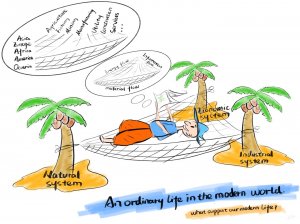
An ordinary life in the modern world: what support our modern life?
- Submitted by:
- Dingfan Zhang
- Authors:
- Wei Xie, Dingfan Zhang, Min Dai, Ju Wang
- Description:
- Everything in the world exists in systems, and our lives are made up of complex systems formed by natural, industrial and economic systems. The three systems are closely linked throughout their life cycle (production, circulation, use, consumption, and disposal) and at all scales (atoms, molecules, substances, parks, industries, and regions). Energy, matter and resources from all over the world travel through the network of complex systems, building the cornerstones of industrial society and supporting the ordinary day of every person in the modern world.
- License applied:
- Attribution-NonCommercial (CC BY-NC 4.0)

Not easy to teach or learn industrial ecology
- Submitted by:
- Souhil Harchaoui
- Authors:
- Souhil Harchaoui
- Description:
- I am wondering if it was easier to teach industrial ecology in the 90s or today.
- License applied:
- Attribution (CC BY 4.0)
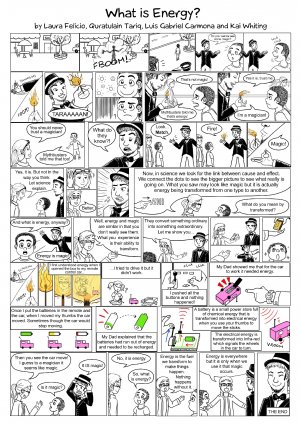
What is energy?
- Submitted by:
- Gabriel Carmona Aparicio
- Authors:
- Laura Felicio, Quratulain Tariq, Gabriel Carmona and Kai Whiting
- Description:
- Modern society must innovatively transform if we are to re-establish a balanced connection with planetary boundaries without jeopardising the meeting of the fundamental needs of billions of people. The global energy system lies at the heart of any sustainable transition. For society to function properly, it requires a considerable amount of natural resources. The latter become transformed into energy carriers for various devices that supply the user with lighting, refrigeration, and/or mechanical drive. In turn, we all harness these processes to obtain energy and material services in the form of visual comfort, thermal comfort, and mobility, etc. The relationship between resource extraction and service provision is of significant interest within the field of Industrial Ecology, especially when it comes to matters concerning decoupling. Societal Energy/Exergy Accounting (SEA) is one thermodynamic-based method employed by industrial ecologists to map and account for the efficiency of energy flows within the energy system. The SEA can capture a general overview of resource use from primary energy sources (e.g., crude oil or hydropower), through to final energy flows (e.g., electricity or refined fuels) and onto useful energy forms (e.g. light, heat or mechanical drive). In other words, an SEA depicts the usable phase of an energy system. It is used to quantitatively ascertain the interaction linking energy extraction and consumption to the provision of energy services. However, the SEA is not easily understood by non-practitioners, which can prevent those outside the field from truly embracing a sustainable energy transition. Various stakeholders must come together if society is going to make significant improvements to our energy systems. We drew this cartoon to raise public awareness and help all members of society, including children, to engage with the challenge of sustainable energy use and transformation. We would like the public to think about energy not only in terms of quantity, but also to be valued for its quality, which is basically a measure of its usefulness. Cartoon caption: The magic of energy. A PDF version of the cartoon can also be found in the following link: https://bit.ly/IS4IECartoon
- License applied:
- No license (all rights reserved)